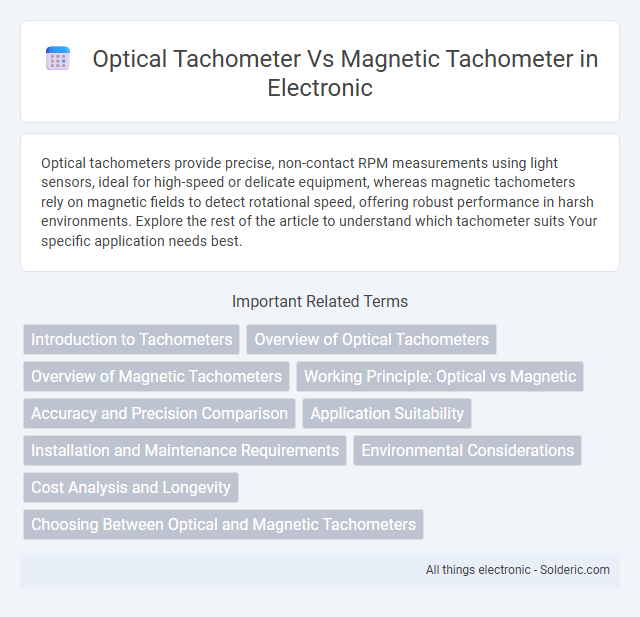Optical tachometers provide precise, non-contact RPM measurements using light sensors, ideal for high-speed or delicate equipment, whereas magnetic tachometers rely on magnetic fields to detect rotational speed, offering robust performance in harsh environments. Explore the rest of the article to understand which tachometer suits Your specific application needs best.
Comparison Table
| Feature | Optical Tachometer | Magnetic Tachometer |
|---|---|---|
| Working Principle | Measures RPM using light reflection from a marked target | Measures RPM via magnetic field changes from a rotating magnet or sensor |
| Contact Type | Non-contact | Usually contact or proximity-based |
| Accuracy | High accuracy with proper alignment | Moderate to high accuracy, subject to magnetic interference |
| Application | Suitable for fast, delicate, or inaccessible rotating parts | Common in industrial machines with magnetic targets |
| Environmental Sensitivity | Affected by dirt, dust, and ambient light | Affected by magnetic noise and metal interference |
| Installation | Easy, no physical connection required | Requires sensor mounting near magnetic field source |
| Cost | Typically moderate to high | Generally low to moderate |
| Maintenance | Low, limited to cleaning optical surface | Low, sensor checks and occasional calibration |
Introduction to Tachometers
Tachometers measure rotational speed, with optical tachometers using light pulses to detect rotation without physical contact, offering high precision and minimal wear. Magnetic tachometers rely on magnetic fields and physical sensors to track rotational speed, providing durability in harsh environments. Your choice depends on application needs for accuracy, maintenance, and environmental conditions.
Overview of Optical Tachometers
Optical tachometers measure rotational speed by detecting light reflections or interruptions from a marked target on a rotating object, providing non-contact and highly accurate readings. They are ideal for applications requiring precision without physical contact, such as motor shaft speed monitoring or industrial machinery diagnostics. Unlike magnetic tachometers, optical types do not rely on magnetic fields, eliminating interference from electromagnetic noise and enabling use on non-metallic surfaces.
Overview of Magnetic Tachometers
Magnetic tachometers measure rotational speed by detecting changes in the magnetic field generated by a rotating magnet or a ferromagnetic target attached to the rotating shaft. These devices provide reliable real-time speed measurements without physical contact, making them suitable for harsh environments where wear and tear are concerns. Magnetic tachometers often offer high durability and precise speed monitoring for industrial applications such as conveyor systems, motors, and generator control.
Working Principle: Optical vs Magnetic
Optical tachometers use a light source and sensor to detect the passage of reflective or marked surfaces on a rotating object, converting light pulses into speed measurements with high precision. Magnetic tachometers operate by sensing changes in magnetic fields generated as a magnet passes by a coil or sensor, producing electrical pulses proportional to rotational speed. Your choice depends on application requirements such as contactless measurement with optical methods or robustness in harsh environments offered by magnetic types.
Accuracy and Precision Comparison
Optical tachometers offer high accuracy by using light pulses to measure rotational speed, minimizing mechanical interference and providing precise, non-contact readings ideal for delicate or high-speed machinery. Magnetic tachometers rely on detecting magnetic field changes, which can be affected by external electromagnetic noise, potentially reducing precision in environments with strong magnetic interference. You should choose an optical tachometer for better accuracy in high-precision applications, while magnetic tachometers remain suitable for robust, industrial settings where slight variations are acceptable.
Application Suitability
Optical tachometers excel in applications requiring non-contact speed measurement, such as high-precision industrial machinery and rotating equipment with reflective surfaces. Magnetic tachometers suit environments with solid metal parts and lower speeds, often used in automotive or heavy machinery settings due to their robustness and resistance to dirt or oil contamination. Your choice depends on whether precision and non-contact measurement or durability in harsh conditions is prioritized.
Installation and Maintenance Requirements
Optical tachometers require precise alignment and a clear line of sight for accurate readings, often necessitating periodic cleaning of sensors and reflective surfaces to prevent errors caused by dust or debris. Magnetic tachometers involve mounting magnetic pickups near rotating parts and require minimal maintenance aside from occasional inspection for secure attachment and wiring integrity. Installation of optical tachometers tends to be more sensitive to environmental conditions, while magnetic tachometers are generally more robust in harsh environments with lower maintenance demands.
Environmental Considerations
Optical tachometers offer non-contact measurement, making them less susceptible to environmental factors such as dirt, moisture, and electromagnetic interference, which often affect magnetic tachometers relying on magnetic fields. In harsh or dirty environments, optical tachometers maintain higher accuracy and reliability due to their resistance to corrosion and signal distortion. Magnetic tachometers can be compromised by strong magnetic fields and metal debris, limiting their effectiveness in certain industrial settings.
Cost Analysis and Longevity
Optical tachometers generally have higher upfront costs due to advanced sensing technology but offer longer lifespan in harsh environments as they experience no physical wear. Magnetic tachometers tend to be more affordable initially but may require frequent maintenance or replacement due to mechanical wear and susceptibility to magnetic field interference. Evaluating total cost of ownership favors optical tachometers in applications demanding durability and minimal maintenance over time.
Choosing Between Optical and Magnetic Tachometers
Choosing between optical and magnetic tachometers depends on the application environment and measurement precision requirements. Optical tachometers offer non-contact measurement, ideal for high-speed rotations and delicate surfaces, providing accurate RPM readings using reflected light signals. Magnetic tachometers utilize magnetic fields generated by rotating components, suitable for rugged conditions and environments with dust or contaminants, offering reliable data with simple installation and maintenance.
Optical tachometer vs magnetic tachometer Infographic

 solderic.com
solderic.com